List of Garden Pests
The A-Z of Garden Pests. Have you got one or more of these garden pests? Check out this list here.
Ants:
Ants in the Garden How to outdo them, it can be done...Aphids:
Little plant sap suckers which nobody likes, ever, despite their multi-colours and styles.
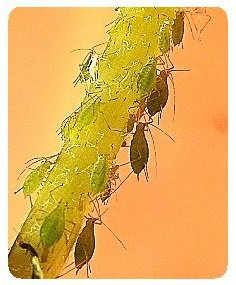
There are green aphids, pink, black and in-betweens. They often produce a generation of winged dudes that fly off and find a new garden to harass.
Soft new growth is their target, but when there are too many and they're jostling for position, they'll go under leaves, on stems, fruits... and still they multiply.

They secrete sticky honeydew as they feed which harbors the growth of sooty mould.
Ants love to harvest the aphids' honeydew, so ants can be a problem too because they 'farm aphids' and move them to new plants to speed up the breeding of more aphids.
Aphids are of the worst pests for seemingly overnight invasions. Good gardeners wander around their patch, whether it be cabbages, roses, tomatoes or just about anything, with crooked thumb and fingers, ready to swipe these little plant damaging munchkins before they MULTIPLY—sorry to shout.
Otherwise, a good hosing often removes them, or any of the sprays on Pest Control page. Keep checking and dealing with them each day or so.
Birds
See Bird Pest Control and Backyard BirdsCaterpillars and Worms
 There are thousands of different caterpillars the world over, from ordinary to weird, and many of them are garden ravagers — darn them.
There are thousands of different caterpillars the world over, from ordinary to weird, and many of them are garden ravagers — darn them.
Common caterpillars that we find are the cabbage worm and cabbage looper which eats holes in many vegetables, including brassicas (cabbage, broccoli, Brussels sprouts, kale etc), tomatoes, spuds, and cucumbers.
It's the pretty butterflies and plain looking moths that flutter around and lay eggs that are the culprits. The eggs are either in clumps or single and usually laid on the underside of leaves, so if you see butterflies, particularly white ones, or brown moths at night, do check daily for damage.
With a few plants you can run finger and thumb over leaves, squashing eggs and picking off any caterpillars, or mix up a spray from the organic pest control page, such as garlic fire or molasses and spray weekly.
A typical lifecycle of a caterpillar, worm or inchworm is usually 4-6 stages (called instars).
A caterpillar eats and eats and over some weeks depending on the variety, it goes through several instars before spinning a cocoon attached to the plant where it pupates.
If winter arrives it stays as a pupa until spring, or otherwise it emerges in a week or so as a butterfly or moth and flies off to look for a nice leaf to lay eggs on. The eggs hatch in a matter of days into caterpillars or worms and the cycle continues.
Cats
 Lots of gardeners have cats and that's nice. You can't expect cats to be nice and do what you want them to do, where you want them to do it.
Lots of gardeners have cats and that's nice. You can't expect cats to be nice and do what you want them to do, where you want them to do it.
They will do what they want to, paw the soil around then have a snooze on top of your seedlings.
Cats like a nice bit of loose soil, so mulch like mad and if you can provide a dirt patch or box somewhere else for use, you may be lucky and train them to use that.
If you're done being nice or it's your neighbour's cats being bad-mannered—a fright or two with a hose often works. Interestingly a cat that purrs on your lap at your neighbour's house will be completely different in your garden. Cats are hunters, and they are wary themselves outdoors.
You won't be able to get close enough to hurt them with water, but you can make them unwelcome. A direct hit amidships from 20ft away is harmless, or keep a water filled soda bottle with a hole in the cap handy or child's water pistol to squirt at them.
Save your citrus peel, especially orange, and cut it up or run over a pile with the lawnmower. Scatter it around garden edges and keep topping up. Cats thoroughly dislike citrus.
Chilli powder sprinkled around will scare them off, and garlic spray works around garden edges. You will go through an awful lot of it, all the time, everywhere you need it, to keep cats away. Miss a corner or forget to spray where they land from the fence next door, and they're in!
Deer
Deer How to repel deer here.Dogs
 This is a hairy one. Apart from providing a shady spot somewhere else instead of between your lettuce rows, a soft bit of lawn or soil to roll around on rather than your seedlings, a bone to chew instead of nibbling your peas, and the most horrible face and voice you can conjure up should the bone look like it might be buried in the potato patch... then give up, or put up a fence.
This is a hairy one. Apart from providing a shady spot somewhere else instead of between your lettuce rows, a soft bit of lawn or soil to roll around on rather than your seedlings, a bone to chew instead of nibbling your peas, and the most horrible face and voice you can conjure up should the bone look like it might be buried in the potato patch... then give up, or put up a fence.
Earwigs
 Eeeewahh... If earwigs are eating your plants, crumple some newspaper in old flower pots and leave them in the garden. The earwigs will hide in the paper once they're done eating.
Eeeewahh... If earwigs are eating your plants, crumple some newspaper in old flower pots and leave them in the garden. The earwigs will hide in the paper once they're done eating.
In the morning, shake the paper out where they can have a new home or into a bucket of hot water if earwigs aren't your cup of tea.
Earwigs don't always eat plants, preferring organic matter on the ground. They do like silverbeet/chard though, and like to hide in these curly leaves. After picking, uncurl and flick or wash any earwigs away.
Fleas
 There are whole websites devoted to killing fleas in the home, so here we'll just deal with fleas in the garden.
There are whole websites devoted to killing fleas in the home, so here we'll just deal with fleas in the garden.
To deter fleas outside use diatomaceous earth and sprinkle it on your shoes and socks as you step into the garden. This way those fleabags won't hitch a ride back inside with you. DE consists of vast amounts of microscopic fossilized, broken down diatoms. It looks like flour and is harmless to animals and humans. It kills small insects and bugs by cutting into their surface, thus causing dehydration. It's often used in grain silos so is available in farmers' stores as well as some health outlets.
It's ok for you and pets to ingest diatomaceous earth as it kills parasites, but it is a very fine powder so avoid breathing it in.
Pennyroyal (sometimes called stinking roger) grown near the door and in the garden gets rid of fleas. There are pennyroyal pet soaps and washes that are sold to protect pets from fleas.
Gophers
 Here are a few tricks to try to deter gophers:
Here are a few tricks to try to deter gophers:
- Encourage birds of prey by putting water bird baths in garden and keeping foliage around the garden edge down so the birds can spot any such rodents.
- Lay mesh around your garden edge at least 45cm (18") deep. Some gardeners even lay it on the bottom of a garden bed.
- Have some pets, such as a dog or even a cat, and make sure they are out and about during dawn and dusk at the same time as gophers get active. Gophers and other burrowing creatures will avoid trespassing where there are family pets in sight.
- Spraying with Garlic fire works but depending on garden size it may be too big a task and too expensive to make enough and keep using it.
- If you already have a few gopher holes, put the hose down them and flood their tunnels.
Green Vegetable Bugs
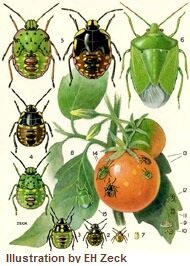
Like most bugs, they go through various stages, starting with eggs laid on the underside of leaves. They love beans, tomatoes, corn and many other plants.
The eggs hatch into coloured nymphs in about 3 weeks, and the nymph's stage is about 80 days as they change to black. They change to the adult green stage which lasts for about 100 days. They can do a lot of damage now and pierce fruit and suck plants' sap.
Best control is by hand, but you do have to really squeeze them! Beware of the brownish liquid and nasty stink they give off.
Otherwise natural wasp and other predators can help. Also use any of the sprays on the natural pest control page, such as the garlic fire spray.
Mealy Bugs
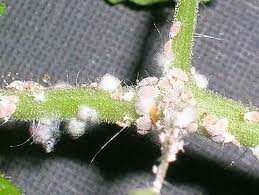 Treat these soft pale pink, white or grey sucking insects the same way as scale. Indoor plants are susceptible to mealy bugs because of the sheltered environment, so in your garden mealy bugs love glass houses and plants growing near or under weather protection.
Treat these soft pale pink, white or grey sucking insects the same way as scale. Indoor plants are susceptible to mealy bugs because of the sheltered environment, so in your garden mealy bugs love glass houses and plants growing near or under weather protection. 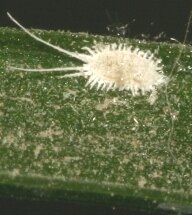
Mealy bugs multiply rapidly and will soon sap the life of a plant, causing distortion and stunted growth first.
They are easy to squish with fingers or dab with a cotton bud dipped in methylated spirits. They have a slight waxy coating so anything that burns this off, such as meths, causes death by dehydration. Smothering with oil is also effective.
Mice
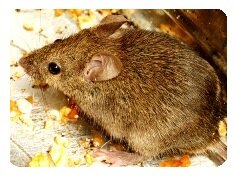 If they get into your home from the garden, smarten up your housekeeping to the point of being fanatical. Don't leave food out, put stored food in containers and empty the crumb tray of your toaster.
If they get into your home from the garden, smarten up your housekeeping to the point of being fanatical. Don't leave food out, put stored food in containers and empty the crumb tray of your toaster.
Deter mice with peppermint or eucalyptus oil—soak cloths or cottonwool and put where mice come in or have been. They tend to go around edges and under appliances, so concentrate your efforts there and if you have to lay traps, bait them with peanut butter, cheese, stiff porridge or bread.
Moles
See Voles and Gophers. Moles eat insects and worms; they don't harm plants except by their earthworks.Possums (Opossums)
 Possum deterrents are many, with only anecdotal evidence that some work. Reliable tests do give credit to camphor to repel opossums. Mix natural camphor flakes or oil to a paste with something like Vaseline and rub around tree trunks, or put camphor in stocking leg or net bag and hang from a branch.
Possum deterrents are many, with only anecdotal evidence that some work. Reliable tests do give credit to camphor to repel opossums. Mix natural camphor flakes or oil to a paste with something like Vaseline and rub around tree trunks, or put camphor in stocking leg or net bag and hang from a branch.
If opossums just love your garden and fruit and veggies, it may be worth your while to fence them out. Use floppy but strong chicken netting just under 90cm (3ft) high supported on lengths of fencing wire that are curved outward at the top so those cheeky possums just get swung around when then try to climb up. Bury the netting 20cm (8") in the ground.
For fruit trees put a smooth, wide metal collar around the trunk to stop them climbing up.
Keeping chickens nearby may also deter opossums.
Scales
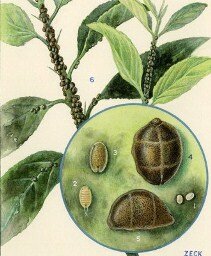 It can be a shock to peer at a plant and realise that it's covered in black, brown or green scale. More of a shock will be when in a short while your plant starts turning up its toes in a stunted sort of way, so tackle scale as soon as you find it. Scale gathers on leaves and stems, sucking the life out of plants.
It can be a shock to peer at a plant and realise that it's covered in black, brown or green scale. More of a shock will be when in a short while your plant starts turning up its toes in a stunted sort of way, so tackle scale as soon as you find it. Scale gathers on leaves and stems, sucking the life out of plants.
A black fungus called sooty mould grows on the sweet honeydew secretions from scale. This does the plants no good and looks awful. Ants also love scale honeydew and will aggressively farm scale to obtain as much as they can.
The odd scale can be scraped off with your nail, blunt knife or toothbrush. Always check a week or so later for any new ones.
Garlic fire spray also works, because it kills the crawling nymphs as well as smothering the waxy coated adults which permanently attach themselves to the plant.
Also mix 1/4 teaspoon of oil, 2 tablespoons baking soda and 1 tablespoon mild liquid soap in two gallons of water. Spray or wipe on plants once a week for 3 weeks or until gone.
Slugs and Snails:
Slug and Snail control Why me, you cry... here's all about them and what to do...Spider mites
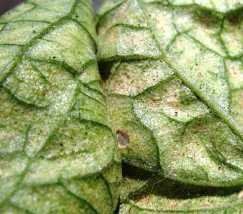 There are unknown millions of mite species, many similar to thrips. In the garden the two-spotted mite is commonly called red spider mite because in the cold weather it changes from pale green with two red spots to orange/red, looking like a miniature red spider.
There are unknown millions of mite species, many similar to thrips. In the garden the two-spotted mite is commonly called red spider mite because in the cold weather it changes from pale green with two red spots to orange/red, looking like a miniature red spider.
Like thrips, spider mites suck the chlorophyll from the leaves of plants. Spider mites leave white translucent spots of damage and no dark droppings. In heavier infestations a silky web is obvious, which is secreted by the mites to protect themselves from enemies and poisons. These webs can cover a whole plant.
Natural predatory mites are the best control, so having compost and mulch to encourage beneficial mites will keep the right balance. Spiders, parasitic wasps, lady bugs and lacewings also feed on red spider mites.
Use a soap spray to eradicate these critters. Spray plants weekly until mites are gone, then monthly to stop them from returning. Also see other sprays under Caterpillars.
Squash bugs

See Green Vegetable Bugs above
Stink Bugs

See Green Vegetable Bugs above
Thrips
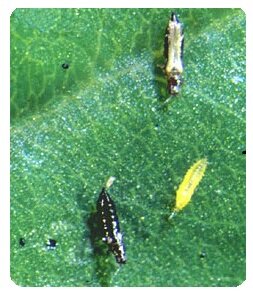 There is no singular word for thrips—such as a thrip. And look at one of their names Heliothrips haemorrhoidalis! So these horribly named beasties come by the gangload.
There is no singular word for thrips—such as a thrip. And look at one of their names Heliothrips haemorrhoidalis! So these horribly named beasties come by the gangload.
Microscopic greenhouse thrips rasp away on the surface cells of leaves and suck out their chlorophyll contents. The hollowed, air-filled cells then take on a silvery, tissue paper look. This later turns brownish and crinkly and there are dark spots of thrips droppings seen.
Some thrips also spread viruses, such as the tomato spotted wilt virus. Not nice.
Keep weeds down if troubled with thrips, as thrips overwinter in nearby ground foliage waiting for their favourite plants the next season.
Garlic fire spray trips thrips up and there are a number of predatory bugs native to different countries. Lacewing larvae are a good biological control also. See Beneficial Garden insects and creatures
Thrips are a blight on the world—as if they cared—as they go about their daily business to suck sap from the leaves of your plants.Leaves take on a whitish frosting as the foliage gets damaged. Thrips hate moist air, but it is still important to keep susceptible species well watered and healthy to make them more resilient to any thrips invasions.
Voles
(Also see Gophers) Unlike Moles, Voles only eat roots and bark rather than insects and worms. Electronic gadgets were popular once for organic garden pest control, but apparently have little success on Voles, so you might have to resort to mouse traps if you're desperate.Bait traps with bread or stiff porridge, then lay the traps on the vole trails, cover each trap with a box with a hole (to stop birds and possibly other animals, and kids) and keep checking and moving and replacing until you win!
Whitefly
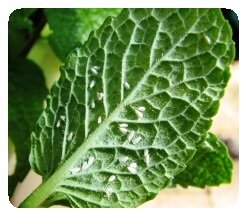 Windy conditions keep whitefly away temporarily, and also a strongish hose down will move them on.
Windy conditions keep whitefly away temporarily, and also a strongish hose down will move them on.
Detergent or oil coats their wings and stops them flying, so mix up approximately 1-2 teaspoons detergent to 1 litre (15oz) water, or half a cup of cheap salad oil to 1 litre water, with a dash of detergent. Spray all over infected plants, including underside of leaves if possible.
Whitefly are attracted to yellow. Get some sticky stuff, such as vaseline, castor oil, natural gum resin, or vegetable wax. Tie bright yellow plastic bag bits coated with sticky stuff to stakes, or smear a yellow plastic bucket, or paint a nearby board the brightest yellow you can buy.
If necessary shake the whitefly off the plants then watch as they land on the yellow traps and get stuck.
See our other pest pages. . .
Organic Garden Pest Control How organic pest control works and when and why solutions are needed
Natural Pest Control Remedies Exactly what you need and how to use.
Controlling Plant Diseases What do they look like and what to do with Pathogens, Fungus, molds, mildew, blight on vegetable plants





